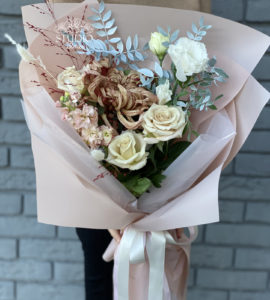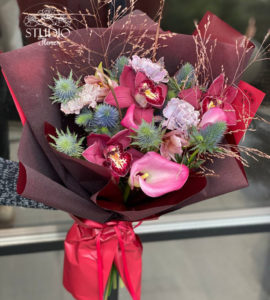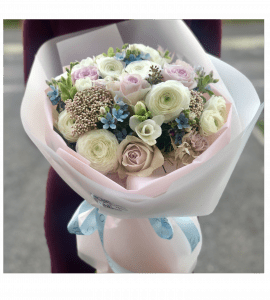It is believed that fresh flowers are not the most practical gift: bouquets can lose their attractiveness within a few days after purchase, and keeping plants fresh in a vase for longer than a week seems an impossible task. However, with proper care, the freshly cut composition will not wither even ten days after purchase. To do this, you need to follow only a few universal rules that can extend the life of any plants. And the bouquet, which contains persistent flowers, will retain its freshness and charm even several weeks after purchase.
Chrysanthemums are the most persistent flowers that can stand in a vase for up to four weeks when left. Cut plants are unpretentious: caring for a bouquet of chrysanthemums consists in changing the water every day, cutting the stems and washing the container in which the composition is located. If plaque has formed on the stems, rinse them too.
These flowers keep freshness for 2-3 weeks: the cooler the room in which the bouquet is located, the longer the composition will stand in the vase. Cloves also need clean water, so it is advisable to change it every day. It is better not to keep these plants in the same container with flowers of another variety: carnations secrete substances that have a detrimental effect on the neighbors in the vase. Like chrysanthemums, carnations are persistent outdoor flowers: they will take longer without water than other plant varieties.
A cut exotic flower stays beautiful for up to two and a half weeks if washed and trimmed before being placed in a vase. Orchids do not respond well to cold, preferring room temperature water with a drop of alcohol. Do not spray flowers or touch their petals: this will accelerate the wilting of the plants.
Sprigs of freesia with graceful inflorescences are an excellent choice for a long-lasting bouquet: these plants delight the eye with freshness for up to two weeks. Caring for them is simple: daily change of water and location away from sunlight and heating appliances. Freesias love water at room temperature, and the stems can be shortened by 1 cm before immersion.
Irises stay fresh for two weeks if you remove excess leaves before immersing the bouquet in water. You can add sugar to the vase as a top dressing and charcoal as an antiseptic. The nutrient solution needs to be changed daily, and the stems of the plant should be trimmed by about an inch every day. It is undesirable to leave irises without water even for a short time: while you are changing the contents of the vase, carefully put the bouquet on the table and wrap it with a damp cloth.
In those countries where white is associated with purity and solemnity, strict snow-white calla lilies are often used as the most persistent flowers for a bride’s bouquet. These plants are able to maintain their fresh appearance without water, but after a whole “dry” day, even calla lilies cannot be reanimated one hundred percent. Squeezing and deformation negatively affects the vitality of these flowers, so it is better to choose spacious deep vases for their content. Callas will last longer in a sugar solution, away from direct sunlight and fruit baskets.
Alstroemeria can be kept in a vase for up to two weeks, if you cut their stems at an acute angle before immersion in it, and add top dressing to the water. These plants are very fond of clean liquid, so it needs to be updated every few days, re-adding nutrients to it, and the container must be thoroughly rinsed. Make sure that the lower leaves of the alstroemeria do not touch the water and remove dried inflorescences to reduce moisture evaporation.
These spring flowers keep their freshness easily for ten days. Trim the stems of the tulips at an angle and place the plants in a tall vase that will support them upright. Tulips love cold water and do not like heat at all, so it is better to place a container with them away from sunlight and heating appliances. The flower holds well in a vase, both alone and in the vicinity of other plants (with the exception of daffodils).
African chamomile lives in a vase for 10 to 20 days. Her lifespan depends on how long she had to be without moisture and what temperature was outside at that time. Caring for gerberas is simple: every day you need to change the water to filtered or boiled, and cut the stems obliquely. If gerberas begin to wilt, you can submerge them whole in water to restore their fresh appearance. It is better to put the container with the bouquet in a bright place without direct sunlight. Moderate spraying will prolong the life of the gerbera composition.
Depending on the species, a rose can stand in a vase from one to two weeks. Due to the variety of varieties, these flowers are often used in wedding arrangements. Most roses love coolness. The water in the vase with them needs to be changed to filtered water daily, the sections on the stems should be updated every two days, and the buds can be sprayed. The lifespan of the plant increases the removal of thorns and lower leaves. The queen of flowers responds well to sugar solution and the addition of aspirin to the vase.
The resilience of summer plants lies in their ability to withstand heat, not in their ability to do without water. Persistent summer flowers include lilies, chamomile, ranunculus, hydrangeas, and sweet peas. These plants get along with each other both when composing compositions and in mono-bouquets.
In order for plants to delight you with their fresh appearance for a long time, regardless of their natural resistance, adhere to a few simple rules:


